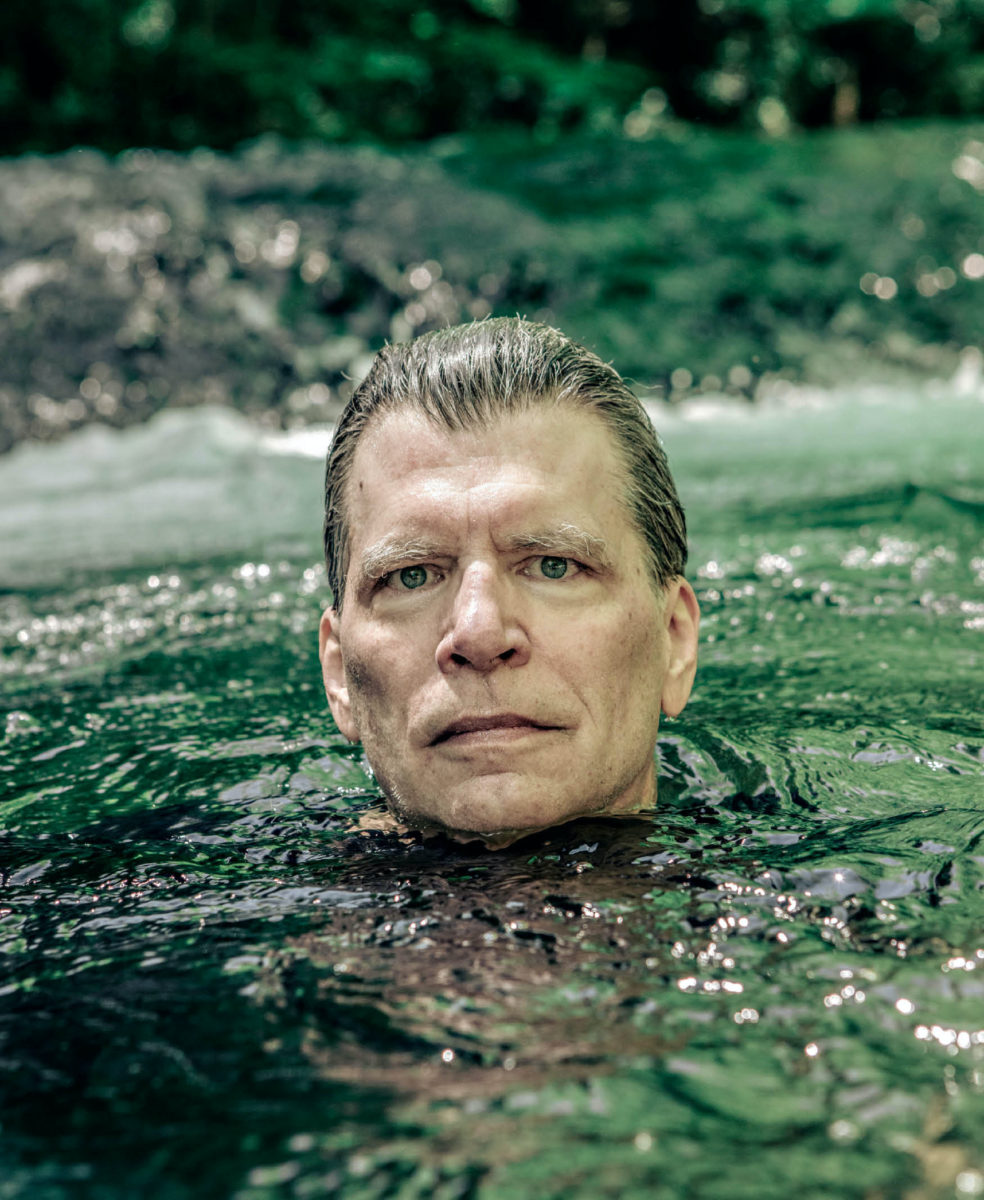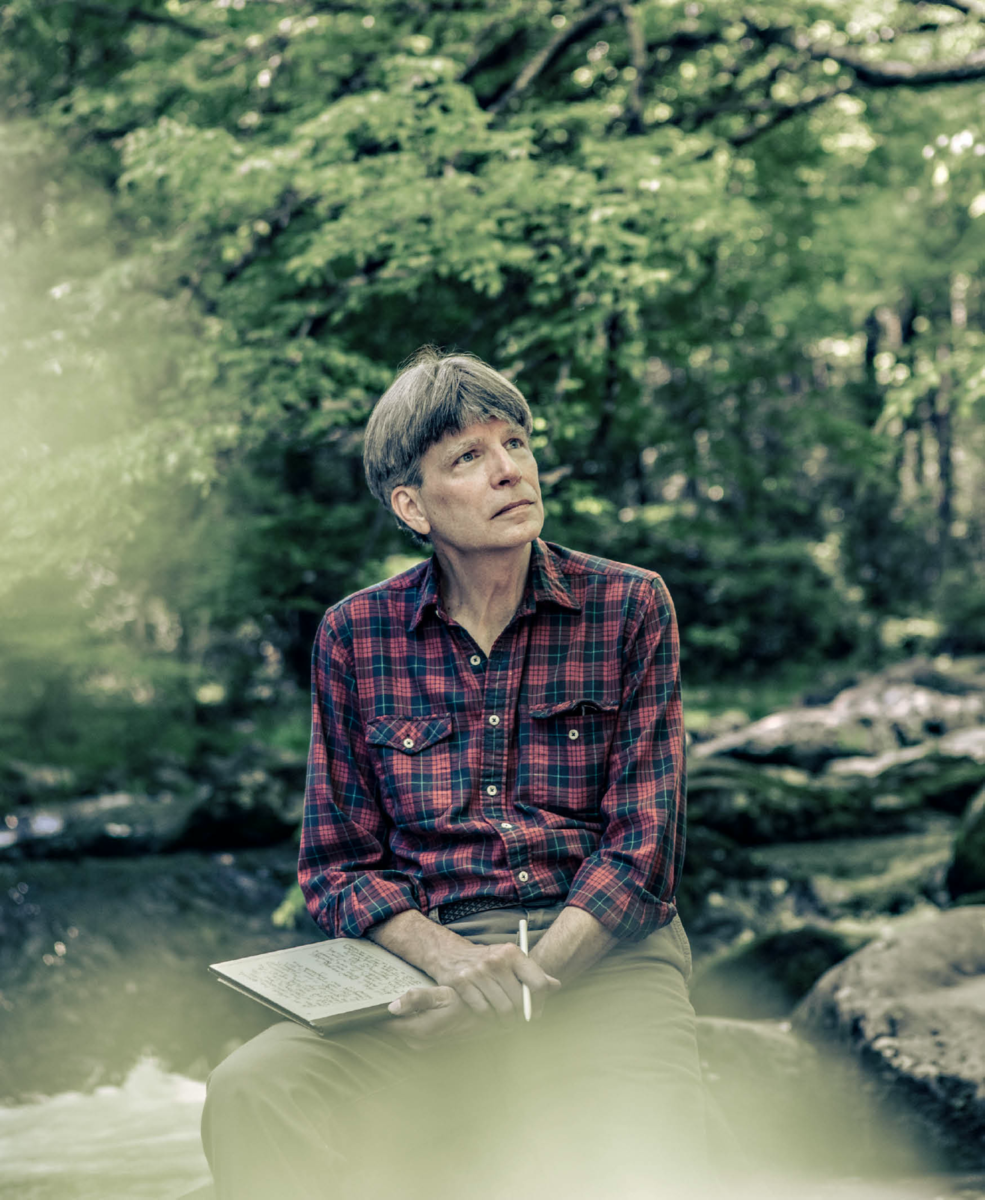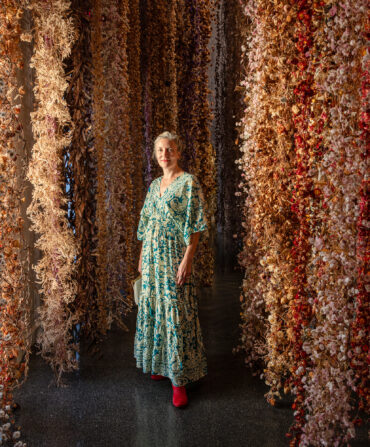Arts & Culture
Richard Powers’s Wild Voice
The novelist’s Great Smoky Mountains immersion laid the groundwork for his epic Pulitzer-winning tree novel. It also sparked a love affair between man and place that is upending Powers’s life and work

Photo: Fredrik Brodén
On a dewy gray morning in April, on the quiet northwestern edge of the Great Smoky Mountains National Park, a pair of retirees from Minnesota encountered a man descending the trail as they were hiking up.
“Did you take in that show on the way up?” the man asked them. The couple knew right off what he was talking about: the explosive blooms of spring ephemerals, all the trilliums and fire pinks and bloodroots and trout lilies they’d been seeing flowering along the trail. “Amazing,” they said. Sensing a fellow plant enthusiast, they asked for the man’s help in identifying one peculiar flower they’d noticed that resembled a “little Christmas tree” poking from the soil.
“Bear corn,” came the answer. “It’s a parasitic plant. It flowers,” but it doesn’t photosynthesize. “And the bears do love it.” The couple exchanged quick happy glances. Could the man help them also ID an unfamiliar tree they’d been seeing, maybe cousin to a horse chestnut? (“That’s yellow buckeye,” he told them.) Could he explain why you see young chestnut trees but almost never mature ones? (“The bark fissures at right around the time they start fruiting, and that’s how the [blight] fungus gets in.”) Or how tall the native hollies grow? (“Twenty-five feet.”) Before long the man was directing the retirees to lay themselves down across the trail so that they could take in the sumptuous, jasmine-like scent of trailing arbutus, a low-growing ephemeral. “I’ll help you back up if you’d like,” he offered. “It’s worth it.”
Eventually the couple moved on, armed with a bit more knowledge and delight about the natural world. Unknown to them, however, was that the man who’d just left them wiser about the trees—a newly minted local named Richard Powers—had a few years earlier done much the same for a nation of readers. Powers is the sixty-five-year-old author of, among many other novels, The Overstory, which uses a starring cast of five trees to tell an epic story about human and ecological trauma, about the fateful intersection of plant life and human life. Barack Obama said the novel changed the way he thought about the earth. Bill Gates did too. The Overstory won the 2019 Pulitzer Prize in Fiction and became a million-copy global best seller. The creators of HBO’s Game of Thrones are developing a series adaptation for Netflix. The book’s success has been the kind that can change an author’s life.
Yet there’s really only one life change Powers thinks or talks about, and this trail is a major part of it.
Richard Powers was not, for most of his life, what you’d call an outdoorsman. The names of plants didn’t interest him; plants themselves barely registered. His childhood was divided between Chicago suburbs and Bangkok, where his father was a school administrator, and he spent much of his adulthood orbiting university campuses in cities such as Boston and Urbana and Palo Alto. His novels tended to reflect that milieu: From Three Farmers on Their Way to a Dance, his 1985 debut, through his landmark The Gold Bug Variations (1991) and the National Book Award–winning The Echo Maker (2006), Powers populated his novels with scientists and theorists and artists grappling with the ethical and philosophical turmoils of genetic engineering, virtual reality, neuroscience, game theory, medicine, and artificial intelligence. Book by book, he gained repute as perhaps the most technologically literate novelist alive, a virtuoso of synthesizing scientific arcana with high art. And while his novels always—to paraphrase a line from Gold Bug—rubbed shoulders with wonder, the wonder was usually at humanity’s capacity to innovate, to solve, to connect, to dream. A pivotal Powers scene often took place in a laboratory or an office. The set lighting was usually fluorescent.
But as a character from an early Powers novel once said: “Nothing we make will ever match sunlight.” Or for that matter a tree, which brings us to the story of The Overstory. That novel’s seed was a hike Powers made into the Santa Cruz Mountains when he was teaching at Stanford and living in Palo Alto. Loggers had a century earlier cleared the giant old redwoods from the slopes—all except for one. It was as wide as a house and as old as Jesus and, like Jack’s beanstalk, seemed to stretch infinitely toward the sky. Powers stood beneath it, squinting upward. “Just coming face-to-face with this creature that was so immense, both physically and temporally,” he recalls, “was like getting hit on the side of the head. I realized that life was unfolding on scales that I hadn’t even contemplated.” He’d been looking at the world, he realized, as if through the wrong end of a telescope. Trees like this weren’t scenery for a novel. Trees like this were a novel.

Photo: Fredrik Brodén
Powers sometimes spends whole afternoons observing the fish in a favorite stretch of river in the Great Smoky Mountains.
Research for what became The Overstory lured Powers to the Smoky Mountains. Along with his wife of twenty-one years, the francophone scholar Jane Kuntz, he traveled east for a three-day visit in 2015. Roughly a fifth of the national park’s half million acres is home to old-growth forest—that is, woodlands that escaped the wholesale logging of the mountains in the late 1800s and early 1900s. Most of us have never set foot in a bona fide old-growth forest; they’re rare, for one thing, and the inaccessibility that helped preserve them means they’re almost never roadside attractions. Powers certainly hadn’t explored one, though he’d glimpsed enough Eastern woodlands to think he knew what to expect. The difference staggered him. “I could tell it almost from one step to the next,” he says. Poplars twenty-five feet around at their trunks. Five-hundred-year-old maples. Mosses, ferns, lichens, rotting snags, primeval funk. “In a forest that has been around for a long, long time, the giants are falling, tearing holes in the canopy, which means now there’s a young forest coming up where that old tree died,” he explains. “So when you walk into the old-growth forest, the light is very, very different.” The light, and also the soil, the smells, the sounds. Powers didn’t fully understand what he was looking at; he was still “plant blind” at the time, he says. But he could tell when his breath had been stolen.
Back home in Palo Alto and elsewhere on his research itinerary, he began chipping away at the novel, sticking to the one-thousand-word daily quota with which he’d produced his eleven previous novels. (For scale, you’re about a thousand words into this article.) But he couldn’t stop daydreaming about the Smokies, about what he’d later describe, in The Overstory, as “the sheer mass of ever-dying life” that he’d encountered in the old-growth. Months passed, then a year. “And I thought to myself, I’m still thinking about that little research trip a year later,” he recalls. “That’s got to tell you something.” Life seemed to be whispering instructions, and Powers obeyed. “I came back and bought a house,” he says, “and I’ve been living here ever since.”
Powers is telling this story at the park’s Chestnut Top Trailhead, just outside his adopted hometown of Townsend, Tennessee (population 574). Powers is slender and tall and, as is his habit nowadays, kitted out for hiking, wearing Merrell shoes and khaki cargo pants. Journalists routinely describe Powers’s appearance as “boyish,” which is most likely owing to the Beatlesque bangs that have long draped his forehead but might also have something to do with his demeanor: He exudes earnest enthusiasms and curiosities the way a sparkler exudes sparks. “I once did a little species count standing right here,” he’s saying. “I got thirty-five species of trees.” That’s roughly the same number of native tree species, he notes, as in all the British Isles. “There was an early park superintendent who said what geothermal is to Yellowstone, what limestone domes are to Yosemite, plants are to the Great Smoky Mountains,” he says. “This place is a botanist’s dream.”
It is also, for Powers, something of a buffet. Heading up the trail, he plucks pink blossoms from a redbud tree and offers them from his palm. “A little spicy, a little fruity,” he says, chewing. “Those are good in a salad.” A few minutes later he pauses to nibble some Solomon’s seal, then a quarter mile later stops to graze some broadleaf toothwort, relishing its horseradish tang. Despite a dry March, he’s been able to take home a couple dozen morel mushrooms so far this spring.

Photo: Fredrik Brodén
After Powers visited the Smokies’ old-growth forest, he made Tennessee his home.
Powers’s foraging chops, like his botanical knowledge, are almost entirely self-taught. “A lot of it is just getting out there with the books,” he says. He’s not yet fluent in sedges and grasses, he admits, and of the park’s more than three thousand species of fungus, he’s only comfortable putting maybe seven on a dinner plate. But, hike by hike, he’s learning. “And that’s why I became a writer,” he says. “It’s an excuse to be an autodidact for the rest of your life.” As a high schooler, after hearing that James Joyce’s Ulysses was notoriously difficult, he got his hands on Stuart Gilbert’s 1930 guidebook and went about decoding Joyce chapter by chapter. He entered college as a physics major (before switching to literature) and following college took a job writing computer code. He could’ve continued coding, or stuck with science, but for the fact that specialization has always given him the willies. As his longtime readers know, Powers is an avowed generalist, a forager in the landscape of ideas. That’s what writing novels allows: “You’re able to reinvent yourself every couple of years with every new project.”
Powers acknowledges, however, that this particular reinvention, here on the green-shaded slopes of the Smokies, is different. In the past, when he’d finish a novel, he’d look forward to the tonic excitement of a new subject: the lily-pad leap from, say, the psychology of happiness (Generosity: An Enhancement, 2009) to the biological patterns in music (Orfeo, 2014). But Powers no longer wants to change subjects. In The Overstory, when a character concludes that his “appetite for human self-regard is dead,” the author might well have been diagnosing himself. “I spent most of my adult life thinking that we [humans] were the only interesting stuff around,” he says. “And it was writing Overstory that opened my eyes and turned me around.” Bewilderment, last year’s follow-up to The Overstory, extends the themes of ecological trauma by saddling a widowed astrobiologist dad with explaining the truth about Earth’s perils to his anxious nine-year-old son. Powers’s next book, another “large-canvas” novel like The Overstory, will take those themes into the ocean, into the planet’s wildest and least understood realm. His artistic entryways are now these: flora, fauna, fungi, fish. It’s not that Powers has given up on us humans, in life or in his fiction. But it’s our relationship to the living planet, rather than to one another, that he now feels called to explore.
That is, when he isn’t otherwise exploring. He has hiked all of the park’s trails on the Tennessee side and has ambitions to join the elite ranks of those who’ve trekked all nine hundred miles of park trails. On less rambly days, he heads to a favorite section of the Middle Prong of the Little River, under the shade of some sycamores, where sometimes he writes and sometimes he sits and sometimes he spies. “What I’ll do is come down with a mask and snorkel,” he says, “and just put my head in the river and stay still.” Eighty species of fish live in the park’s rivers, he says, and within minutes many of them will be finning past his mask. “Fourteen-inch trout that you’d think couldn’t live in a river this small,” he says. “Endangered darters and chubs and madtom catfishes.” During spawning season, when certain species of fish take on an orange hue, Powers will lose track of both time and bodily sensation while marveling at all those orange swirls. At least once he’s skirted close to hypothermia.
His longtime editor, John A. Glusman, has occupied a front-row seat to what he calls Powers’s evolution, having shepherded nine of Powers’s novels into print. Glusman has grown accustomed to updates from the mountains about trees leafing, ephemerals flowering, streams rising. The Smokies landscape has become part, he says, of Powers’s “daily vocabulary.” Of that landscape, Glusman says, “I think he embraced it at the same time he was embraced by it.”
“I don’t see myself leaving this place,” Powers says. “When I moved here, it was the first time ever as an adult that I’ve lived where I live.” To belabor a tree metaphor, Powers finally feels rooted. The very architecture of his days has changed; they’re no longer built around his old thousand-word quota. They start, instead, like this: “I open the window, I check the temperature, or maybe I’ve been sleeping outside on the deck. I look at the sky, I look at the weather forecast. Where do I want to be? What’s going on out there right now? Let’s go have a look. But usually what happens is I get out and walk around and then I have to get to the computer or to pen and paper because now the ideas are coming. So it may be that I make my thousand words anyway, but that’s not the day’s purpose.”
It’s not just Powers’s workday purpose, however, that the Smokies have reoriented; it’s his life’s purpose. He’s taken on the mantle of the artist’s goal as laid out by Leo Tolstoy: “to make people love life in all its countless, inexhaustible manifestations.” The distinction, though, is that for Powers life must include every last genus of it, plant or animal, single-celled or multi-. “I think that’s my day job now, to be in the world and to try to understand it better,” he says as the Chestnut Top trail curves upward into a grove of wild rhododendrons and into dark stands of spruce and fir, their fallen needles carpeting the trail. “I just learn more and more about what’s out there, and about how absolutely astonishing and tenacious and inventive and resourceful and mind-boggling it all is. And then I just try to identify with that, and live among all those incredible neighbors.”







